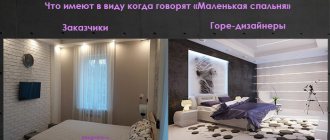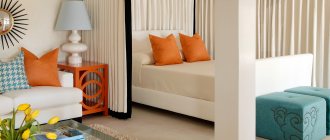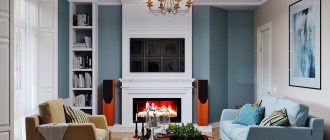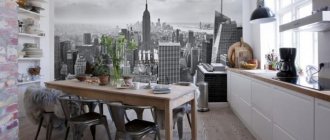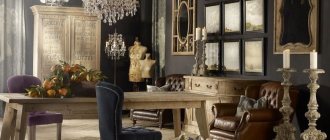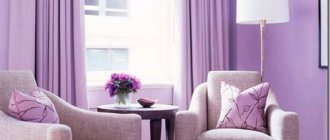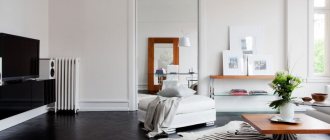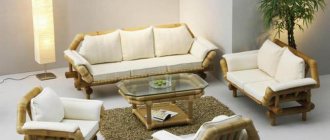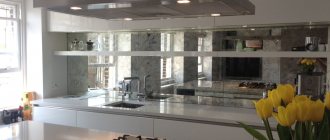Laconic style Home comfort and romance Ancient classics
Take a look at the photo of wallpaper for a small living room: in such interiors you can use materials of many shades, and modern fashion practically does not dictate conditions regarding the placement of finishing materials. But if you are afraid that with new wallpaper your room will no longer feel as spacious as before, listen to our recommendations.
Basic rules for decorating small rooms using wallpaper
Consumers looking to make a small room feel larger have a variety of issues to consider, such as which space-enhancing wallpaper to choose.
A positive result can only be achieved here using the method of optical illusions. One of the basic rules is the rejection of dark accents and finishing materials. To increase space, no matter how illogical it may seem, you can use zoning. But this needs to be done correctly, using clear lines and interior items that will surround the area. For example, when choosing wallpaper for the kitchen, it is necessary to abandon contrasting techniques, since they immediately attract attention and emphasize the lack of free space. Bulky objects cannot be called expandable in space. Even in combination with wallpaper that visually enlarges the room, all attempts will be in vain. After all, this will only make the interior look untidy, but it will also become inconvenient to use such a room.
Since corridors in apartments are usually the narrowest place in a home, it is necessary to select finishing materials for them that increase the area. It is better to avoid dark patterns, as they will absorb all the light and in this part of the house there is usually only artificial light. Colors that do not expand, but rather reduce free space, are warm shades:
- yellow;
- orange;
- red.
They should be abandoned if the windows are as small as possible and the room is narrow and long.
Rule 5: Accent Wall
Accent wall decorated with themed wallpaper
One of my favorite techniques that I can recommend to anyone and everyone is an accent wall. Using an accent wall can not only decorate your home, but also make it feel more spacious.
An accent wall finish combines white walls with dark furniture
What colors to choose for accents? In general, I advise choosing a color or print that contrasts with the rest of the surfaces in the room.
The wall at the head is covered with canvases based on the principle of contrast
When the interior contains an unusual ornament or intense color (except yellow and red), I recommend choosing a color similar to this color or print.
The accent wall is in harmony with the gray-turquoise ceiling
As an accent, you can use not the entire wall, but only a part. This could be the headboard, the area by the fireplace, or any other place that deserves special attention.
Dark finishes draw the eye to unusual objects adjacent to the wall
The location of the accent wall also depends on the furnishings of the room, the location of openings (windows and doors) and, of course, on your preferences.
The influence of texture and texture on spatial perception
Embossed wallpaper is in demand, with the help of which they not only decorate the room, but also make the space more free. Discreet, voluminous models are appropriate in any style and are indispensable for those who prefer the classics.
The walls shine, the shimmer fills the house with light, the walls repel. The effect is enhanced by adding glossy or mirrored ceilings to the finish. You just need to remember that many small furnishings in the interior will double in size.
Complex relief lines distract the visitor’s attention from the volume of the room. A small room looks great when covered with textured wallpaper with small patterns. Such walls are pleasant to the touch and form a sophisticated backdrop. More preferably, the coating is made in a combination of colors.
The most popular textures:
- Wool. The surface of the wallpaper reproduces the dense surface of the fabric.
- Dust. The surface is fine-grained, a good basis for decoration.
- Canvas. The outer layer imitates a porous structure.
- Malta. Deliberately sloppy relief over the entire surface.
A coating that imitates brickwork, brick, leather or metal helps to place modern accents and decorate a room with an antique look. Construction materials that can be repainted more than once create an interesting design.
Smooth and textured coatings can be easily combined if you have difficulty choosing.
What are photo wallpapers made of?
Photo printing is performed on the same materials as regular wallpaper. The most common:
- Paper;
- Fleece;
- Vinyl;
- textile.
Fabrics can be single-layer and have a double-sided base. In this case, the lower layer sometimes differs from the upper one in its structure and properties.
Fleece and paper are great for creating breathable walls in wood, adobe and other materials.
Vinyl coating does not allow air to pass through. For this reason, it is often duplicated on paper or polyester backing to improve performance.
Wallpaper color that visually expands the room
The rooms in modern apartments are not very large. You can expand the space only visually using original design techniques:
- universal method - selection of wall finishes in light colors;
- skillful combination of shades and textures.
It is not recommended to use dark colors (burgundy, dark brown, black or dark purple). It is also worth remembering that large motifs and dense small prints visually reduce the space. But such restrictions cannot be considered too categorical, since there are many interesting ways to transform any apartment with the help of colors and textures.
Style for a small living room
For the design of a small living room, styles that combine lightness, light shades and uncluttered details will be suitable.
Modern style is neat and functional. Calm colors, clear lines, modern materials and technology will create an excellent atmosphere for business people.
The design is a bit reminiscent of an office environment, but it can always be diluted with homemade pillows, indoor plants, and cute cozy textiles.
Wallpaper colors and patterns for small rooms
Wallpaper for a small room should be selected taking into account the color and pattern found on it. Many people are afraid to connect light and movable walls for fear that they will join together and the interior will be boring. There are many successful examples of design using white, gray, and beige colors. For a small room this will be the best solution.
It should be remembered that the furniture should have a different shade - be darker than the wallpaper and the surrounding interior.
It is advisable to choose cool color options. They are working on expansion. These should be abandoned:
- Contrasts. They visually cut the room into parts. They are suitable for use in large spaces. For example, for their zoning. This method is not suitable for small areas.
- Bright saturated colors. Such wallpaper will visually narrow the room and turn it into a box.
- Wide and contrasting patterns. Their perception in such a room will be impaired, since dimensional drawings emphasize a small area, and brightness aggravates the situation.
Tips for decorating a small room with photo wallpaper, how to “pull apart” the walls.
A contrasting wall is allowed. To do this, one side of the room is highlighted using a pattern. It would be better if they were geometric shapes. What's special about this? The color scheme of this surface should be calm and not differ much from the general style. Thus, it will fool the eyes: any person will think that the space is larger than it actually is.
There are several rules for decorating walls with wallpaper:
- Opposite sides can be decorated in the same color scheme, but contrast them with cold and light shades.
- How to shorten long walls? To do this, use wallpaper with a small print; for short walls it is better to leave a large pattern.
- Diagonal placement of pictures on the wallpaper will also visually lengthen the space.
- The method of different color saturation is also very popular. To achieve the desired effect, the bottom of the walls is covered with darker tones, and light ones are placed on top. This method is ideal for small rooms with low ceilings.
- It is also possible to alternate the background with and without a pattern. However, to expand the volume of the room, plain canvases should be larger than wallpaper with ornaments.
- A glossy finish is recommended. They create an increase in the area of rooms, as they have the property of reflecting objects in front of them.
Rule 2: looking for the right stripe
Wallpaper in soft lilac tones matches the textiles of the room
Are you crazy about stripes, but don't dare use them to decorate the walls in a tiny room? You've probably come across the "wrong" strip. Depending on the desired effect, striped wallpaper can and should be used in small rooms.
How can a vertical stripe help?
Light striped wallpaper emphasizes the luxury of a classic ambience
If you have low ceilings, I recommend finishing the walls with vertical striped wallpaper. And if the drawing and the background do not differ much in color, you will achieve a double effect, because your room will become more spacious. This is a great option for those who want to choose wallpaper for a small, dark room.
The presence of purple does not clutter the bedroom
A vertical stripe can lighten a room, even if the design is dominated by a rather dark and deep color. Due to the gradation of different shades of the dominant color, the interior softens and becomes more elegant.
This effect can be created with purple, turquoise, burgundy, gray and brown wallpaper.
Vertical stripes are more than appropriate in attic-type housing
Where there is clearly a lack of a high ceiling, a vertical stripe comes to the rescue. Feel free to use this pattern in attic spaces.
What can a horizontal stripe do?
This active pattern gives the room volume
If your goal is to visually expand the room, horizontal stripes will help. The thinner the strip, the more noticeable the effect. Wide stripes will practically not change the proportions of the walls. Take a closer look at your home and decide which ones are right for you.
In the photo - an acceptable option for “Stalin”
You will need thin horizontal wallpaper if you live in a “Stalin” building or in a house with high ceilings.
Important points about gluing
Among the stripes are the basic colors in which the interior items are decorated.
So, how to hang striped wallpaper so that it works in your favor? The instructions are simple:
- It is important to choose a design with maximum accuracy, so I advise you to buy one roll more than you counted by footage;
- Before gluing, take care of a perfectly flat surface - putty and then prime the walls;
- When the striped canvases lie on flat walls, only then will the visual effects of the striped wallpaper take effect.
Wallpaper with the right prints for a small room
Wallpaper with prints and patterns will organically fit into modern interiors of any style. Of course, to create a general background, it is advisable to choose canvases with a light base. Nuances of material selection:
- typical for designs in country style, Provence;
- geometric prints (squares, diamonds, circles) will add dynamism to the interior and make the decor in the high-tech and minimalist style laconic and effective. Abstract shapes painted in contrasting colors fit original into modern and retro designs;
- a fashionable trend is materials that imitate the texture and texture of rough surfaces (masonry, concrete, concrete). Such wallpaper for a small room, which visually enlarges the space, can be called accent wallpaper. They will emphasize the naturalness of the loft, Provence style;
- We can't help but mention the striped pattern. Pasting with such wallpaper is a universal way to enliven a space and visually change the geometry of the room.
Is it possible to wallpaper with a geometric print and a floral pattern at the same time in a small room? It may seem that such a combination is unrealistic, but designers suggest experimenting and choosing materials from the same color palette.
Minimalist styles
Usually this style is intended for large rooms, but the interior design of a small living room in a loft will look very unexpected with bare walls, panoramic windows and a minimal amount of furniture.
A minimalist style also presupposes a minimum of things; there is only the most necessary furniture and a complete absence of decorations.
Scandinavian style offers light shades of decoration, an abundance of light, spaciousness and lightness. This design will create a feeling of freshness and remind you of light coolness and endless spaces.
How to visually enlarge a room with wallpaper?
- A long, narrow room can be visually expanded with horizontal striped wallpaper.
- If there is wallpaper with flowers up to 3 cm in diameter on the wall and on the bottom wall, for wallpaper with dark flowers but more than 5 cm in diameter, use this
- By using bright colors on the back and side walls, the room will appear closed, expanding up and down.
Consider using wallpaper in a small room, it is recommended to remove it if you use it at the right time.
Glitter wallpaper is one of the best ways to expand your space. They will reflect the light that will be paid to those who live on Khrushchevka or in the community. In the bedroom it is better to place them on the wall located behind the head of the bed, in the living room - behind the sofa.
Finishing
It is better to decorate very small living rooms with high-quality materials. Of course, natural finishes are best, but you can use less expensive bases to save money.
We recommend reading:
Wallpaper for the living room in an apartment - wallpaper options for the living room, photoLiving room with kitchen in a modern style: kitchen-dining room design ideas
How to decorate a living room in English style?
Room design ideas that expand space
There are several design techniques that can visually increase the area of a small room. One of these techniques is to cover a panoramic wall of a room with photo wallpaper or 3D wallpaper. High-quality photographic images that have appeared in recent years are not inferior to frescoes in terms of impression, price advantage and speed of execution. 3D walls can transform a small room or studio beyond recognition.
Wallpaper for a small living room
The living room is the main room in the house, and it should be decorated as effectively as possible. Photo wallpaper can be used to decorate and expand the space of a small room. In most cases, the wall behind the sofa is more suitable for this purpose.
In the photo, the wall of a small living room is effectively decorated with vintage photo wallpaper and images of predatory animals, which adds dynamism and originality to the interior.
In the photo, the back wall of a small hall is decorated with photo wallpaper, on which images of bright house facades look very attractive. This design technique will not leave any guest indifferent.
Decorating a small dining room
When you want to decorate your dining room in an unusual way and there is not enough space in a small apartment, you can use images that expand the space and effectively highlight the dining area. The dining room in studio apartments, covered with expressive wallpaper, looks very nice.
How to visually enlarge a small bedroom?
When choosing wallpaper for a small bedroom, it is best to decorate it in subtle colors and patterns that are pleasing to the eye, promoting relaxation and restful sleep.
Wallpaper for a small children's room
For children's rooms, it is recommended to use easily replaceable finishing materials. When children grow up, the wallpaper can be easily re-pasted, changing the atmosphere of the children's room.
In the photo, the combination of stripes and plain wallpaper not only added austerity to the boy’s nursery, but also brought dynamism and variety to the small room.
The photo shows a nursery for a little princess. The walls are covered with wallpaper with birds. The small room looks gentle, bright and sunny.
Wallpaper that enhances the kitchen
Small kitchens, especially kitchens in Khrushchev, can be visually enlarged to a square if you don’t just decorate the walls with traditional tiles, but use expressive, bright wallpaper. Geometric patterns, stripes or shapes will perfectly highlight the geometry of kitchen appliances and appliances. And bright accents add dynamics, and a small room seems larger.
Panoramic photo
A wall with a sofa or a pair of chairs will be a good place to place panoramic wallpaper. The main thing is to choose a picture, creating a relaxing atmosphere for relaxation.
These options are made of durable paper with the addition of vinyl. This is the most durable, but more expensive and difficult to maintain material.
If you choose a living room design with photo wallpaper , you will be able to hide minor wall defects. This is due to the thickness of the material.
How to enlarge a room with wallpaper: 5 ideas
Light wallpaper
The color of the walls, or more precisely the wallpaper, can greatly affect our perception of space. Cool shades make small, cramped spaces feel airier and look better than their darker, warmer counterparts. Another solution that can help brighten up a room and give it extra depth is an accent wall. Experts advise using wallpaper with a discreet, but no less original design, and choosing white, cream and pastel shades.
Panoramic wallpaper
You can also visually enlarge the room with the help of panoramic wallpaper, decorative panels, wall paintings or wallpaper with a trompe-l'oeil pattern. They can be used for an entire wall or part of it in the living room, or they can be used to decorate the headboard wall in the bedroom. A landscape on the wall will help create the extra perspective that small spaces lack, and will create the effect of an endless and elusive space.
Wallpaper on the bottom of the wall
Another trick is to cover not the entire wall with wallpaper with an active print, but only its lower part. A wall split in half horizontally will appear taller, and the lower section will add depth to the room. This option is well suited for loft rooms.
4.Photo wallpapers and frescoes
The quality of photo wallpapers is now very different from what was offered in the Soviet era. Modern photographs, frescoes that are fashionable today are of excellent quality, realistic, and last for many years. Any room will become more spacious, more original, and warmer if you use materials with the right pattern in the design.
Elegant canvases are made to order, based on the size of the room and the general furnishings. They take into account not only the design, but also the purpose of the room. Images of flowers, fields, and waterfalls are suitable for the kitchen. In the bedroom, an image with a terrace and spatial texture is appropriate. Urban and natural themes are popular in the living room. The visibility of three-dimensional space will be created by patterns in 3D format.
Frescoes used for decoration are made using different technologies and have different sizes and shapes. Even in a small room, they can completely occupy the ceiling or one of the walls, provided that the image has a perspective that imitates an open balcony, an alley stretching into the distance, or the expanse of the sea. The theme is selected based on the style of the room.
Wallpaper that hides room imperfections
Wallpaper with an active pattern is a good way to hide all the architectural flaws of the room. They will help hide unnecessary protrusions, hide a niche and smooth out all the unevenness of the walls.
rgstedt
How to glue photo wallpaper
The preparatory process is very important; at the stage of purchasing glue and rolls of photo wallpaper, you need to choose only trusted manufacturers. Since this or that pattern will be depicted on the canvas, the clarity of the lines and the brightness of the colors should be at a high level.
Fixing liquid is purchased according to the type of material; the composition may vary slightly. When applying glue, a wide brush is used; professional painters use a roller to smooth the surface; in its absence, you should take a dry rag.
Advice! In some cases, you will need to trim the edges by cutting pieces of material with a construction knife; an ordinary spatula will help to maintain straight lines. Its metal part must be pressed tightly in the right place and drawn along the edge with a sharp blade.
What to consider when choosing wallpaper for small rooms
When choosing wallpaper you need to pay attention to two features:
- Quality and type of material (paper, non-woven fabric, vinyl, liquid fabric, foil, cork, with mineral spray).
- Appearance (texture, texture, color).
When choosing a material, only the functional purpose of the room is taken into account. The appearance should correspond to the design style and emphasize the advantages of the room, masking its shortcomings.
Style and design of the room
The style of the room is the very factor that determines the choice of decoration and furniture details. First, they focus on a certain direction in design, study its features, and only then select wallpaper, furniture, and decor. Decorators highlight a separate line of styles that are perfect for small spaces of standard and non-standard shapes. Here are three popular leaders:
- Minimalism. The breath of the East, bursting into the art of modern design, is a long-awaited discovery. Minimalism can be characterized by the single principle of “nothing superfluous.” The room is decorated in white with rare splashes of gray or black, they use only the necessary furniture set, and practically do not spoil the interior with furniture. This approach allows you to rid the room of unnecessary things, as a result of which it begins to look larger than it actually is.
- Scandinavian. The cold blue of the fjords, the dazzling shine of artificial snow caps in the sun, rare spots of greenery and the piercing blue of a clear sky. This is the only way to describe the natural color scheme of the Scandinavian style. The interior should glow slightly from the cold, which is melted by the warmth of the fireplace and the warmth of animal skins lying on the sofa or armchair. Scandinavian style is northern, strict and uncompromising. Here, too, unnecessary details will look inappropriate, as in minimalism
- High tech. A modern trend characterized by an abundance of mirror and chrome surfaces. The combination of neutral white and gray will open up an illusory extension in a small room with additional square meters.
Wallpaper for minimalism is devoid of texture and any pattern. They are monochromatic and may seem boring to connoisseurs of eclectic medley. In the Scandinavian style, they often resort to the “wall separation” technique. Wallpaper with a pattern or print covers only one surface, which will become an accent. The rest remain monochromatic within the acceptable color range for the Scandinavian style. For high-tech, you can use unusual foil wallpaper that will harmonize with the chrome surfaces of furniture and decor.
Drawing and texture
Texture is a special relief on the surface of the wallpaper, which often forms a certain pattern. Most designers agree that raised shadows add volume to a room and are suitable for small spaces. If you need wallpaper with a delicate texture, you should pay attention to vinyl and paper. On them, convex areas protrude above the surface by only 1-2 mm. “Liquid” wallpaper has the most pronounced texture. Drawing is another important feature. Wallpaper without an image is called plain. The rest can be conditionally grouped into several groups:
- Striped wallpaper. Scratching walls has never gone out of style. Vertical stripes are more common than horizontal stripes. The former are ideal for small rooms with low ceilings. Vertical stripes lengthen the space and visually “lift” it. Horizontal lines expand the room, but at the same time lower the ceiling. First, decide on the type of room you have (small with a low or high ceiling), then proceed to choosing striped wallpaper.
- Cell. Another “timeless classic” design. Plaid goes well with rustic style. It brings order and at the same time light notes of anger when performed in rich colors. Don't cover the entire room with checkered wallpaper. This is not a prison. An accent wall is enough. The combination of cells and floral motifs looks gentle and familiar. This is one of the favorite combinations in Provence.
- Floral motifs. There are enough options for floral wallpaper design that even a fastidious designer will find it “the same.” In small rooms it is not recommended to use wallpaper with large flowers. It is better to opt for delicate miniature field bouquets or small inflorescences.
- Wallpaper with large and small stains. They can also be called abstract. Such wallpaper perfectly masks unevenness and defects of the walls. Large dots make the space visually smaller, while small dots, on the contrary, move the walls away from each other.
Color spectrum
Color is the main criterion for wallpaper. It can visually make the room larger, but it is important to choose the right combination of shades for the walls, floors, ceilings, and later furniture. Black and all dark colors are not suitable for such rooms. Blue, light blue, turquoise, cobalt, asphalt gray in combination with the whiteness of the ceiling will add air to the room. These shades are recommended to be used if the room has a large window and a lot of natural light. For those rooms whose windows face the shady side, it is better to choose a duet or trio from a variety of warm shades: yellow, ocher, light brown, café au lait, peach, pink. Unfortunately, these tones will not affect the visual perception of the size of the room, but will make it much warmer and more comfortable. Saturated bright colors look good only in combination with calmer, faded shades. A striking example of such a combination is the “different walls” technique.
Basic Techniques
It is not necessary to cover all walls with the same wallpaper. For modern interiors, such a traditional method will be quite boring and dull. Designers have long come up with a number of techniques for combining surfaces of different textures and shades that are suitable for both large and small rooms. We will get acquainted with some layout options for two or more types of wallpaper further.
Reception of “Different Walls”
This method will require two types of wallpaper: plain and bright with a pattern or textured surface. The principle of combining is to cover opposite walls with the same wallpaper. You should be careful with rooms of non-standard configuration. Cold shades make the object move away, so blue, light blue, and green wallpapers are not recommended for finishing “short” walls, as the room will seem even narrower.
Reception separation
Space division can be done in two ways:
- Horizontal;
- Vertical.
In both cases, you have to sacrifice something: either the height of the ceiling or the width of the room. The first option is suitable for small rooms with high ceilings. It helps to cope with the so-called well effect. Horizontal separation is usually carried out at a height of 0.5-0.7 m from the floor. The strip can be “adjusted” to some large piece of furniture. For example, the back of a sofa, the head of a bed or a dining table. In rooms with windows, they are guided by the height of the window sills. The vertical division visually raises the ceiling. Usually two types of wallpaper are combined, which differ in color and texture. There are a lot of combination options: symmetrical, asymmetrical, narrow stripes with wide double or even triple ones. If you need to completely erase the boundary between it and the wall, one of the strips of wallpaper “extends” to the ceiling, making the angle between the surfaces inconspicuous.
Accenting
This method will require two types of wallpaper: simple, plain and bright, with an original pattern that attracts attention. The first to paste over three walls, and the second - the remaining fourth. It will become the accent, the main highlight of the interior. In the bedroom, attention is drawn to the wall against which the bed rests with the headboard. In the living room, this is the surface behind the back of a large sofa. In the kitchen, the role of an accent wall is played by the one that became the background for the dining group.
Alternation
Alternation is carried out using both two and three types of wallpaper. Unfortunately, the second option is not suitable for small rooms, since excessive diversity will not benefit them. You can combine different wallpapers: plain with floral or geometric patterns, striped or checkered with florists, abstract with different motifs. For small rooms, it is better to opt for single-color wallpaper, which will highlight the brightness of the floral pattern or the richness of wide stripes.
Reception diagonal
Covering one wall with wallpaper diagonally is an extraordinary and bold decision. The best option for such an experiment would be vertically striped wallpaper. An unusual wall will greatly distort the space and it will be perceived completely differently.
Ideas for using photo wallpaper in the design of small rooms
They also resort to photo wallpapers that visually enlarge the room. This is a pretty cool and effective way. But you should take into account the characteristics of each of the paintings. Not all drawings on the panel will give the desired result.
A background that enhances space should contain images that go deeper into the image:
- forest path;
- street in a big city;
- undersea world.
Another rule is that vertical images optically lift the ceiling.
Selecting and gluing photo wallpaper is a complex process, and there are several design secrets that will help you correctly place panels in a small room:
- Promising wallpaper should be glued to a wall in a room where there are no windows or doors.
- You cannot darken or cut out the image using furniture. For a wall with photo wallpaper, a low sofa, table or bed is suitable.
- The smaller the room, the clearer the wallpaper pattern should be.
- For rooms facing the sunny side, you should choose cool tones, and for those who need light, warm tones are suitable.
Designers also often use backlighting for wallpaper. This method does work. It is used in both small and large rooms. Flashlights should be used for flashlights. They can be placed in a frame; they can be used to “raise” bedside tables or a bed.
In addition, built-in lighting is often used in niches - this helps to achieve a volume effect and visually add space to the room.
On video: wallpaper that expands space.
Features of color selection
In a small room there should not be very dark, saturated colors. They will definitely “eat up” about 40 percent of the space. But our task is to maximize the visual perception of the room.
However, you should not do a snow-white finish, so that the room does not look like an operating room. Most suitable colors:
- cream;
- light beige;
- sand;
- light yellow;
- light pink;
- grey;
- peach,
- gray-blue;
- grey-green;
- light green.
When choosing a color scheme, it is important to consider the lighting of the room. If there is little penetration of natural light into the room, choose warm shades. If there is a lot of sun in it, then cool tones are suitable. It is also worth choosing the color of the wallpaper based on the shade of the furniture and large accessories.
Enlarging a room by combining wallpaper
The combination technique will help increase the height and width of the room.
- Covering the same color range, but of different intensity. Both backgrounds and monochrome patterns are used. The lower part of the wall is covered with darker ones, the upper part with lighter ones. In order not to “steal” the height, the border is chosen thinner. The bottom of the finish should not exceed one meter.
- A room of up to 10 square meters can be decorated vertically with two types of wallpaper. In a larger room, 3 types of different materials are also glued. “Comrades” should match well in color and pattern. It is better not to overdo it with horizontal and bright combinations; in the bedroom it is better to place “ripples” on the head so that they do not irritate the eyes before bed.
- An accent wall, on the contrary, is placed in the field of view. It is covered with beautiful expensive wallpaper and you can admire its beauty while sitting with a cup of coffee in the kitchen or relaxing on the sofa in the living room.
- Sometimes the emphasis shifts to the ceiling. Then it becomes a continuation of the accent wall. A small room is not finished with dark materials, so that the ceiling does not put pressure on the psyche. The juxtaposition of “comrades” is smoothed out, redistributing attention to the surrounding decoration.
- A small bedroom can be covered with dark wallpaper only if it is close to a square shape. The walls near the window or any other part of the room are darkened, except for those walls that should reflect sunlight.
- In cramped spaces, large flowers cut out from your favorite wallpaper, silhouettes of a kissing couple on the head of the bed, glued to a discreet background or small houses, elephants in the nursery will come in handy in cramped spaces.
3D photo wallpaper in the living room interior
Realistic 3D images only work with good and proper lighting. In this case, you need to carefully choose which side the window is on, how the sun's rays usually fall, and where the sources of artificial light are located. Most often, 3D photo wallpaper is placed on the sofa.
For a painting to come to life, it needs a suitable frame. An elephant that walks straight into a room will become a normal flat image if it hangs a plasma screen in front of its ear. The pier, buried in the morning fog, is completely lost against the background of a hanging chest of drawers in the minimalist style.
Designers often choose photo wallpaper with a beach print for the living room. This pattern is refreshing, helps you relax and unwind.
Combine the TV with the picture. Find a place for it. The requirement of realism from the designer. Fortunately, today it’s easy to order both renderings and large-format printing.
If it is impossible to do without furniture, it is better to choose a smaller format photo wallpaper and find a suitable place for it.
How to use wallpaper to increase space - tips from designers
When solving such a difficult problem, you won’t have to give up bold tricks. The wallpaper itself would be a great option for the ceiling, but you need to use the wrong shade to apply to the walls. You can visually open the sky above your head with the help of blue canvases. Ceiling light sources should be abandoned. If the renovation is carried out in the bedroom, then the ceiling can be decorated by gluing canvases with images of the starry sky.
If you don't want your walls and ceiling to lack detail, think about how to combine colors. You can expand the space by making the main colors a little darker. They should become lighter as you go up. This is how avant-garde interiors are usually decorated.
Attention! If you are not afraid of non-standard creativity, then striped wallpaper can be pasted diagonally. This not only focuses attention on the walls and distracts it from a small space, but also visually expands the room.
Techniques for increasing the height of a room:
- If you don't just focus on the background, you can consider additional techniques to increase the height of your ceilings. You can achieve the result with the help of lamps and lampshades, the light of which will be located from the bottom up. It will also make the room more comfortable.
- If possible, the window opening should be extended vertically. But this approach is only relevant in a private home.
- If it is not possible to work with a window opening, you can try raising the top of the doorway to the ceiling. Modern designers generally recommend making doors almost invisible. For this purpose, special doors are used, and the plates are completely removed.
Decor
There is no need to overload a small room with too many decorations.
Small modular paintings, a vase of flowers, indoor plants, a small number of open shelves and elegant figurines will be quite enough to create an atmosphere of comfort.
Furniture and equipment are also selected to a minimum.
Photos of a small living room will help you better understand the arrangement of this room.
Examples of wallpaper for a small room that visually increases the space (photo)
Horizontal arrangement of different wallpapers
Example No. 18
Today, this method is simply morally outdated - this is hello from the first European-quality renovations of the nineties. Then the first companions and paper borders appeared on sale. The very squeak of fashion. But today there are simply no good modern examples of such a combination of wallpaper. I named it so that the list is complete, for information. You'll just know it's there, but keep in mind that it's best not to use it for the next 50 years.
The horizontal line cuts the wall into two parts and hides the height of the ceiling.
Badly
